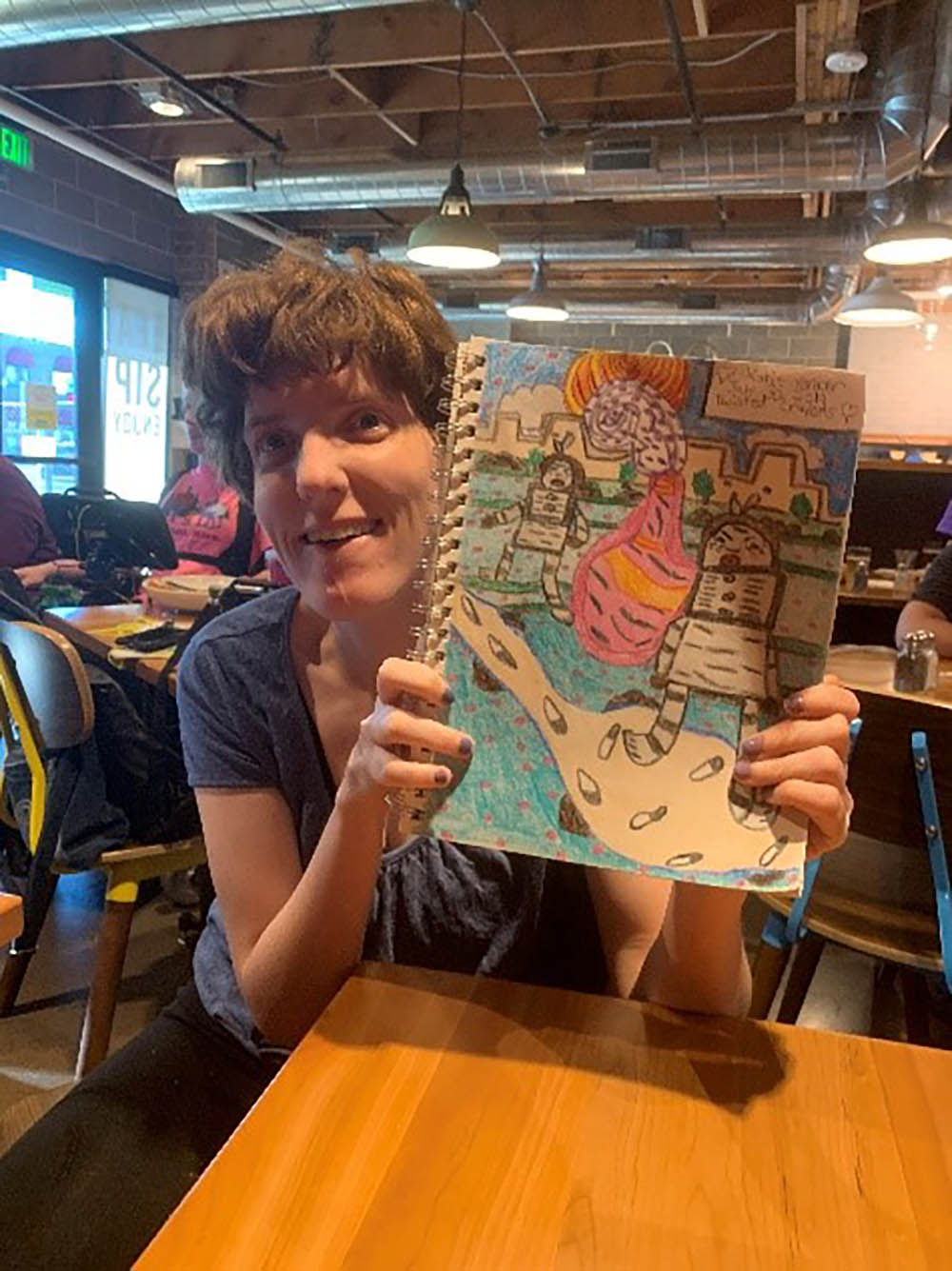Katie’s Story
 Katie held up her portfolio of drawings, pleased that I had asked to see them. I had been invited to an evening of “Stories of Ourselves.” I wanted to learn how those with language disabilities shared their stories. Katie, born with cerebral palsy, became my joy-filled teacher.
Katie held up her portfolio of drawings, pleased that I had asked to see them. I had been invited to an evening of “Stories of Ourselves.” I wanted to learn how those with language disabilities shared their stories. Katie, born with cerebral palsy, became my joy-filled teacher.
She tapped out her message for me. “This drawing comes from my imagination,” said a strong male voice, generated by Katie’s Window tablet that serves as her speech generating device. I wondered why her machine cannot carry her voice and then I realized she has probably never had a voice. Still, I was disappointed.
Katie has used twistable crayons to create a book of colorful drawings and many of them hold secrets to her story. Who she is.
“Robots!” I exclaimed, attempting to guess the subject matter on the cover on Katie’s portfolio. She nodded with delight. This evening my job was to help those with limited language ability to share their stories. As we flipped through her portfolio, I was taken by the vibrant colors and meticulous detail Katie had etched on each page. I oohed and awed as I turned the pages.
In the end we returned to the drawing of robots, and I sensed this work was especially important to her. Katie was born with cerebral palsy and suffers from hemiparesis which has left her walking lopsided most of her life—but walking. She hears out of one ear and often communicates by tapping out responses on her tablet since she struggles to speak. Together we studied her robot drawing.
It was composed of two half-human, half-robot women. I pointed to the one in foreground, and I named her “Alpha Robot,” and the one behind her, I called “Beta.” Katie clapped with delight at these names. We had an easy rapport. These robot women walked forward on their own, but their limbs were twisted, and they appeared to struggle. Of course, this reminded me of Katie’s own struggle to walk. The robot torsos were box-like machines. Because of her tightly bobbed hair, Alpha Robot, reminded me of Katie. When I asked if Alpha Robot depended on her machines to speak and navigate the world, Katie nodded and joyfully high-fived me with her hand. I suspected she understood the connection I made between her and the Alpha Robot, and it pleased her. I was thrilled at how flawlessly Katie used her body movements as well as her art to share “the story of Katie.”
Both of the robots appeared to be screaming and running, and I puzzled over this. Since Alpha Robot seemed to be scurrying across a white carpet that was littered with footprints—or knives, I wanted to ask, “Are they running from something dangerous? Maybe knives?” But I held my tongue, and I found myself wondering if Katie’s world sometimes feels like she must walk through a minefield of sharp knives. Then I turned my attention to the brilliant pink swirl that poured from the heart of Alpha Robot. “Coming from her heart,” I said as I pointed to it. Katie nodded vigorously. The pink swooped upward like a huge Chagall vase of flowers. From the mouth of this vase burst two of the biggest and most glorious roses to ever bloom, one white and one orange–like the full-bodied roses my mother grew.
“Wow!” I exclaimed tracing the trajectory of these amazing blooms. Katie clapped at my reaction then she fumbled with her phone before handing it to me. To my surprise the screen framed a poem Katie had written. Although the words were a bit jumbled, I could easily interpret her message. The title was “The Perfect Prejudice.” “I know I am different and weird,” she wrote. Then she explained how it hurt that other people constantly made fun of her. She wished others could see inside her heart. It they could, she noted, they would know the truth–“I am a good person.” I read the words aloud. Then I looked back to the Chagall vase of flowers springing from the robot’s heart. To Katie’s delight, I traced them again. Then I thanked her for the gift of her story and hugged her.

 Story You Need to Tell
Story You Need to Tell
